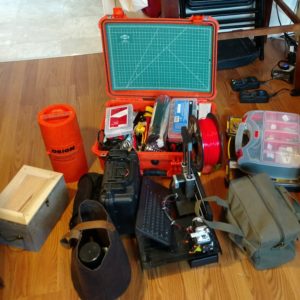
All electronics kits are not created equal. Between the OpenROV, Oceanography for Everyone, and hack-a-thons around the world, my work has taken me out of the lab and into the field, fantail, and classroom to build instruments, hack oceanographic equipment, and train next generation of open-science oceanographers. This has placed a huge new demand on my standard kit, a collection of electronics and hardware tools and components that allow a creative maker to build anything, anywhere. Portability is key, but portability comes with it’s own challenges, especially for that most vital of electronics tools, the humble, powerful soldering iron.
A good soldering iron is absolutely critical to the kinds of projects and workshops I run. Without it, we can to the delicate electronics work necessary for getting a piece of equipment working in the field. But traveling with soldering irons is a nightmare. These high-wattage devices don’t always play nice with local electrical infrastructure. Even using the *right* power converters we’ve blown fuses and burned out power supplies. In the best case scenarios, the irons just don’t produce enough heat to get the job done. In remote regions, local options are often non-existent. When we go, we bring everything with us.
There are portable soldering irons, but they have their own problems. Gas-powered irons require a fuel source that may not be easily obtained and are not always welcome on flights. They also lack the fine control we need. Electric options tend to be of the “cold heat” variety, which is a poor tool for circuit board work and can generate a current that burns out components and shorts your project. Heat-based electric soldering irons are weak, short-lived, and often utterly ineffective. I resigned myself to lugging large soldering stations around the world, hoping for the best when it comes to finding an adequate power supply.
And then I discovered the Hakko FX-901.